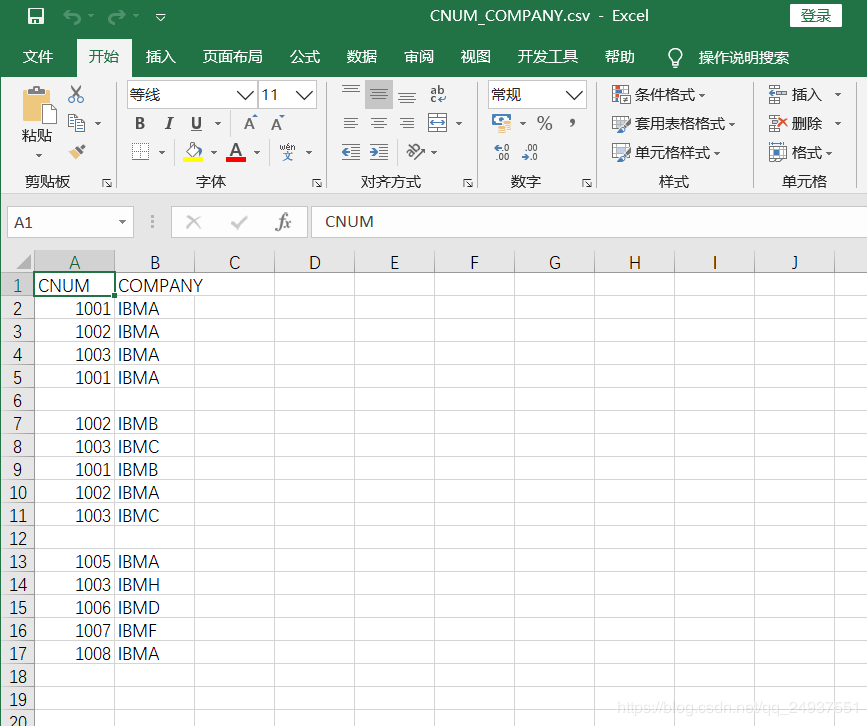需求:
现有一个 csv文件,包含'cnum'和'company'两列,数据里包含空行,且有内容重复的行数据。
要求:
1)去掉空行;
2)重复行数据只保留一行有效数据;
3)修改'company'列的名称为'company_new‘;
4)并在其后增加六列,分别为'c_col',‘d_col',‘e_col',‘f_col',‘g_col',‘h_col'。

一,使用 python pandas来处理:
import pandas as pd
import numpy as np
from pandas import dataframe,series
def deal_with_data(filepath,newpath):
file_obj=open(filepath)
df=pd.read_csv(file_obj) # 读取csv文件,创建 dataframe
df=df.reindex(columns=['cnum','company','c_col','d_col','e_col','f_col','g_col','h_col'],fill_value=none) # 重新指定列索引
df.rename(columns={'company':'company_new'}, inplace = true) # 修改列名
df=df.dropna(axis=0,how='all') # 去除 nan 即文件中的空行
df['cnum'] = df['cnum'].astype('int32') # 将 cnum 列的数据类型指定为 int32
df = df.drop_duplicates(subset=['cnum', 'company_new'], keep='first') # 去除重复行
df.to_csv(newpath,index=false,encoding='gbk')
file_obj.close()
if __name__=='__main__':
file_path=r'c:\users\12078\desktop\python\cnum_company.csv'
file_save_path=r'c:\users\12078\desktop\python\cnum_company_output.csv'
deal_with_data(file_path,file_save_path)
二,使用 vba来处理:
option base 1
option explicit
sub main()
on error goto error_handling
dim wb as workbook
dim wb_out as workbook
dim sht as worksheet
dim sht_out as worksheet
dim rng as range
dim usedrows as byte
dim usedrows_out as byte
dim dict_cnum_company as object
dim str_file_path as string
dim str_new_file_path as string
'assign values to variables:
str_file_path = "c:\users\12078\desktop\python\cnum_company.csv"
str_new_file_path = "c:\users\12078\desktop\python\cnum_company_output.csv"
set wb = checkandattachworkbook(str_file_path)
set sht = wb.worksheets("cnum_company")
set wb_out = workbooks.add
wb_out.saveas str_new_file_path, xlcsv 'create a csv file
set sht_out = wb_out.worksheets("cnum_company_output")
set dict_cnum_company = createobject("scripting.dictionary")
usedrows = worksheetfunction.max(getlastvalidrow(sht, "a"), getlastvalidrow(sht, "b"))
'rename the header 'company' to 'company_new',remove blank & duplicate lines/rows.
dim cnum_company as string
cnum_company = ""
for each rng in sht.range("a1", "a" & usedrows)
if vba.trim(rng.offset(0, 1).value) = "company" then
rng.offset(0, 1).value = "company_new"
end if
cnum_company = rng.value & "-" & rng.offset(0, 1).value
if vba.trim(cnum_company) <> "-" and not dict_cnum_company.exists(rng.value & "-" & rng.offset(0, 1).value) then
dict_cnum_company.add rng.value & "-" & rng.offset(0, 1).value, ""
end if
next rng
'loop the keys of dict split the keyes by '-' into cnum array and company array.
dim index_dict as byte
dim arr_cnum()
dim arr_company()
for index_dict = 0 to ubound(dict_cnum_company.keys)
redim preserve arr_cnum(1 to ubound(dict_cnum_company.keys) + 1)
redim preserve arr_company(1 to ubound(dict_cnum_company.keys) + 1)
arr_cnum(index_dict + 1) = split(dict_cnum_company.keys()(index_dict), "-")(0)
arr_company(index_dict + 1) = split(dict_cnum_company.keys()(index_dict), "-")(1)
debug.print index_dict
next
'assigns the value of the arrays to the celles.
sht_out.range("a1", "a" & ubound(arr_cnum)) = application.worksheetfunction.transpose(arr_cnum)
sht_out.range("b1", "b" & ubound(arr_company)) = application.worksheetfunction.transpose(arr_company)
'add 6 columns to output csv file:
dim arr_columns() as variant
arr_columns = array("c_col", "d_col", "e_col", "f_col", "g_col", "h_col") '
sht_out.range("c1:h1") = arr_columns
call checkandcloseworkbook(str_file_path, false)
call checkandcloseworkbook(str_new_file_path, true)
exit sub
error_handling:
call checkandcloseworkbook(str_file_path, false)
call checkandcloseworkbook(str_new_file_path, false)
end sub
' 辅助函数:
'get last row of column n in a worksheet
function getlastvalidrow(in_ws as worksheet, in_col as string)
getlastvalidrow = in_ws.cells(in_ws.rows.count, in_col).end(xlup).row
end function
function checkandattachworkbook(in_wb_path as string) as workbook
dim wb as workbook
dim mywb as string
mywb = in_wb_path
for each wb in workbooks
if lcase(wb.fullname) = lcase(mywb) then
set checkandattachworkbook = wb
exit function
end if
next
set wb = workbooks.open(in_wb_path, updatelinks:=0)
set checkandattachworkbook = wb
end function
function checkandcloseworkbook(in_wb_path as string, in_saved as boolean)
dim wb as workbook
dim mywb as string
mywb = in_wb_path
for each wb in workbooks
if lcase(wb.fullname) = lcase(mywb) then
wb.close savechanges:=in_saved
exit function
end if
next
end function
三,输出结果:

两种方法输出结果相同:
四,比较总结:
python pandas 内置了大量处理数据的方法,我们不需要重复造轮子,用起来很方便,代码简洁的多。
excel vba 处理这个需求,使用了 数组,字典等数据结构(实际需求中,数据量往往很大,所以一些地方没有直接使用遍历单元格的方法),以及处理字符串,数组和字典的很多方法,对文件的操作也很复杂,一旦出错,调试起来比python也较困难,代码已经尽量优化,但还是远比 python要多。
到此这篇关于vba处理数据与python pandas处理数据案例比较分析的文章就介绍到这了,更多相关vba与python pandas处理数据内容请搜索代码网以前的文章或继续浏览下面的相关文章希望大家以后多多支持代码网!





发表评论